Trijicon Accupower 1-8x28
I've had the pleasure of experiencing Trijicon's Accupower 1-8x28 optic for the last three months. For those of you who may be looking for a low power variable optic for duty use, this is an optic you really need to take a look at.
Low power variable optics
Optics are pretty much the norm on long guns at this point in time. You'll typically see them in one of three flavors: a red dot, a red dot with magnifier, or a variable power optic. If you had talked to me 4-5 years ago, when my work and training primarily revolved around distances 50 yards and closer, I might have been completely on board with nothing but a red dot. Back then, I probably wouldn't have seen the utility of a variable power optic (outside of long-range work). Now, after working with low power variable optics for a few years, I am completely in the opposite camp, for two primary reasons.
- The utility: If you can't see and identify a target, you can't shoot it. For military members, police officers, defensive shooters, and even competitive shooters, the additional magnification on a LPVO makes a huge difference in the "see & ID" realm. It can literally mean the difference between "Yeah, I can see a guy over there," and "I see an individual matching the suspect's description and carrying a gun." Yes, a magnifier behind a red dot can do that as well, but magnifiers are typically fixed in the lower power range, usually 4x or lower. Popular LPVOs can have a high end magnification that's twice that - up to 8x. That higher magnification also makes more precise shots possible, whether a suspect behind cover or an elusive steel plate at distance.
- The versatility: Red dot magnifiers typically give you two magnification options - all or none (usually in 4x or 6x fixed). Fixed magnification optics give you a fixed power of anywhere from 1.5-4x. LPVOs give you 1x, 6-8x, and everything in between. This is important, because as the magnification increases, the field of view typically decreases. Having a variable power optic allows you to pick the magnification that works for your scenario, whether that is CQB on 1x, scanning a larger area on 2-4x, or taking a more precise shot on 6-8x. Most modern LPVOs have an illuminated reticle, such as a crosshair or horseshoe, specifically so that they can perform the close quarters battle role of the red dot at 1x. In addition, because of their etched reticles, even if the illumination fails, you still have at least limited use of the optic.
The Accupower
So with that background out of the way, let's talk about the Trijicon Accupower. The Accupower 1-8x28 is a first focal plane, illuminated low power variable optic designed for duty and competition use. It is offered in a number of options, including subtensions in minute of angle (MOA) or milliradians (MIL) and a red or green illuminated reticle. My review optic was the green MOA reticle. I should probably mention something about the difference between first and second focal plane (FFP or SFP) quickly. There are more in-depth articles here [http://www.shootingtimes.com/optics/optics_poptics_101107/] and here [http://rifleopticsworld.com/first-vs-second-focal-plane-scope/], but in general, the biggest thing to know for a duty LPVO is that the subtensions (whether MIL or MOA) for a FFP scope are accurate at any magnification level. Most popular LPVOs on the market are SFP, which means that if you are using the subtensions to compensate for drop, those subtensions are only accurate at one magnification level (usually maximum magnification). For any other level of magnification, you have to do math on the fly. On a FFP scope, there is no math involved.
The Rundown
Brightness Adjustment Dial
Everybody hates having to go all the way around the dial to turn their optic off. Trijicon fixed that for you. The Accupower offers eleven brightness settings, and they put an "off" in between each one. Basically, if you are running your optic at level eight and need to take a break, one click up or down will turn the illumination off, and one click will turn it back on. This is so very much better than the eight clicks down, then eight clicks back up that many optics require. The brightness dial also houses the compartment for the 2032 size battery that powers the illumination. One of the things to be aware of is the life on the battery. Trijicon advertises greater than 30 hours of illumination from the battery. While this is true for total life, you will notice a significant drop in brightness before reaching 30 hours. I should note that this is a common problem among similar scopes using this type of battery, so I'm not knocking the Accupower in particular. Just know that if you're using a scope that relies on a 2032, you're not going to get the same battery life that you might expect out of your legacy red dot sight. [caption id="attachment_1235" align="alignnone" width="5184"]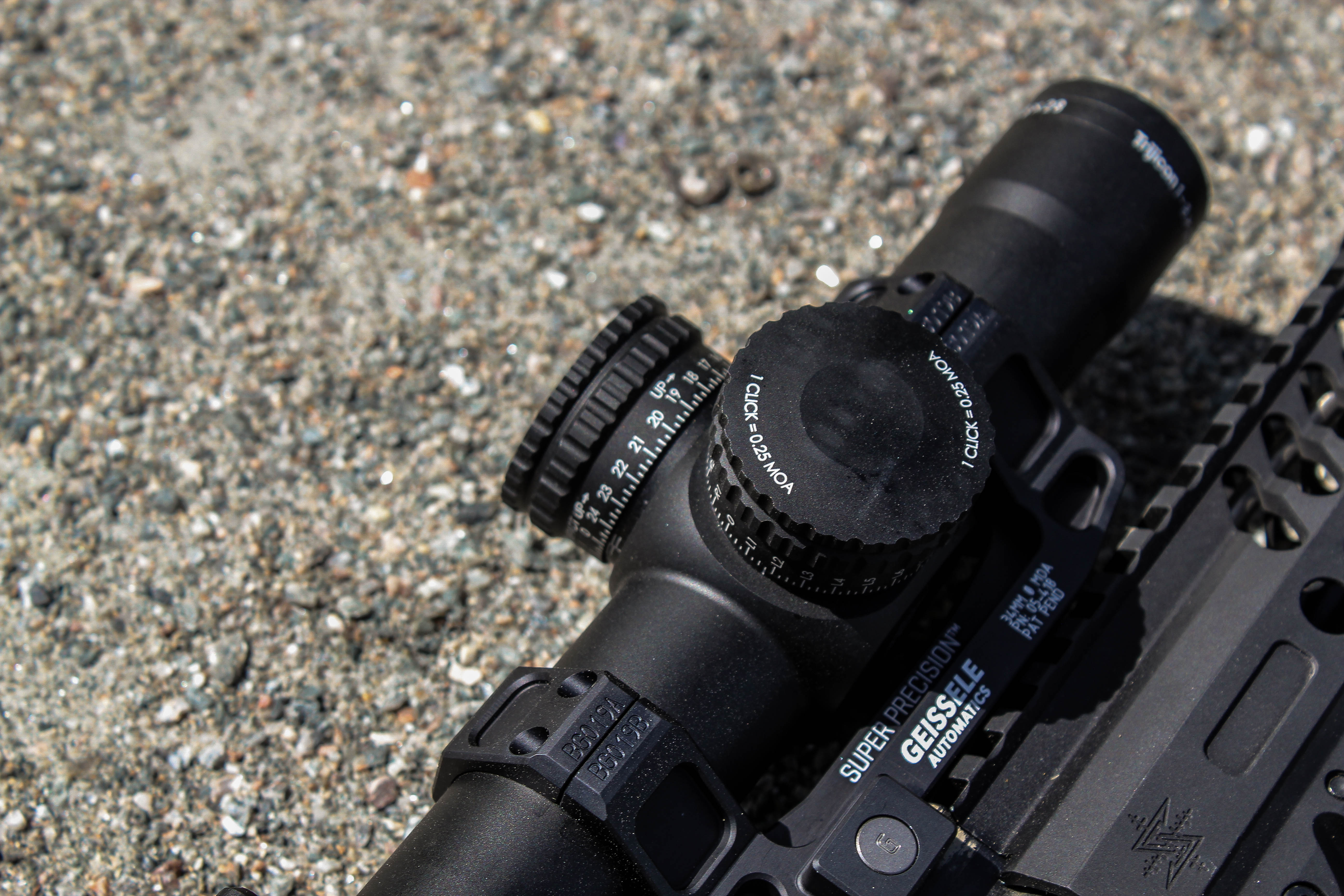 The windage and elevation adjusters are easy to manipulate, even with gloves[/caption]
The windage and elevation adjusters are easy to manipulate, even with gloves[/caption]
Windage/Elevation Adjusters
The locking windage and elevation dials are easy to manipulate and easy to reset to zero. To manipulate these dials, pull away from the scope to unlock, dial to the needed value, then push back down to lock. To reset the dials after initial zeroing, no tools are needed. Simply unscrew the top of the dial, lift the adjuster body, return to zero and press the adjuster body back down. Screw the top back on, and you're done. The dials are well-marked and easy to read, and have very positive clicks for each 1/4 MOA or 0.1 MIL. [caption id="attachment_1236" align="alignnone" width="5184"]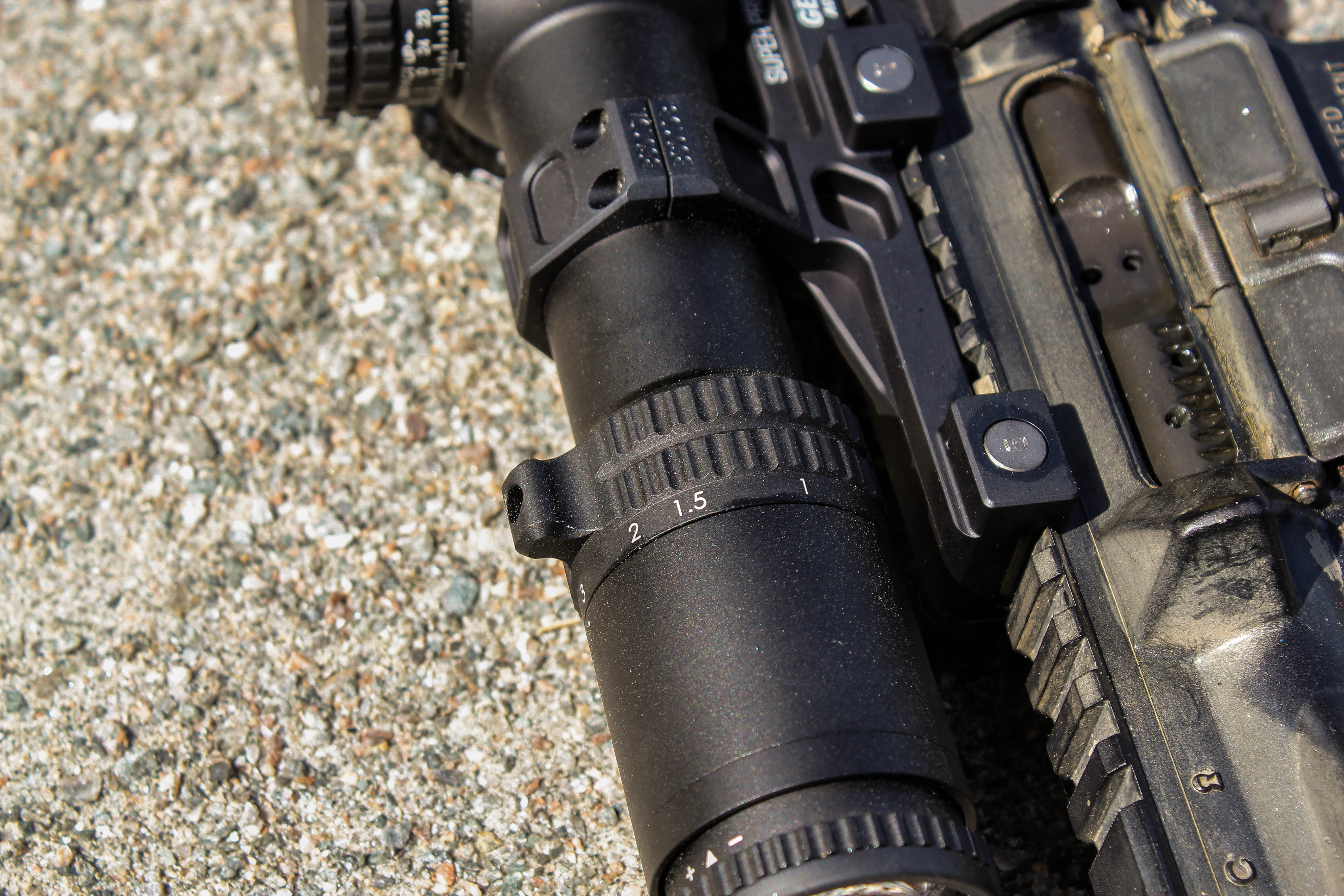 The magnification dial has a slightly enlarged lever for quick dialing[/caption]
The magnification dial has a slightly enlarged lever for quick dialing[/caption]
Magnification Dial
The magnification dial is actually pretty similar to other scopes on the market. It's not as easy to use as Trijicon's VCOG line, but the integral lever is large enough to get a good grip, yet small enough that it's not a snag hazard. The lever is larger than some competitor's models, and Trijicon does sell an add-on Magnification Lever if you feel that the stock one still isn't quite what you're looking for. All told, the magnification dial is solid and contributes well to the overall usability of the scope.
Reticle
Overall, I really like the reticle on this scope. As I mentioned above, you can get the reticle in green or red illumination, MOA or MIL subtensions. It isn't a ballistic drop compensator, per say, but that's because Trijicon aimed to make this scope more versatile. With a BDC, the scope is really only good for the particular ammunition it is calibrated for (typically 5.56 or 7.62 in today's market). With MOA or MIL subtensions, you can use the scope for any caliber. All you need to know is the ballistics of the round you're using. You can also conduct rangefinding and a host of other activities. It might be a little slower to learn initially, but it's a lot more useful as a duty optic. [caption id="attachment_1237" align="alignnone" width="2825"]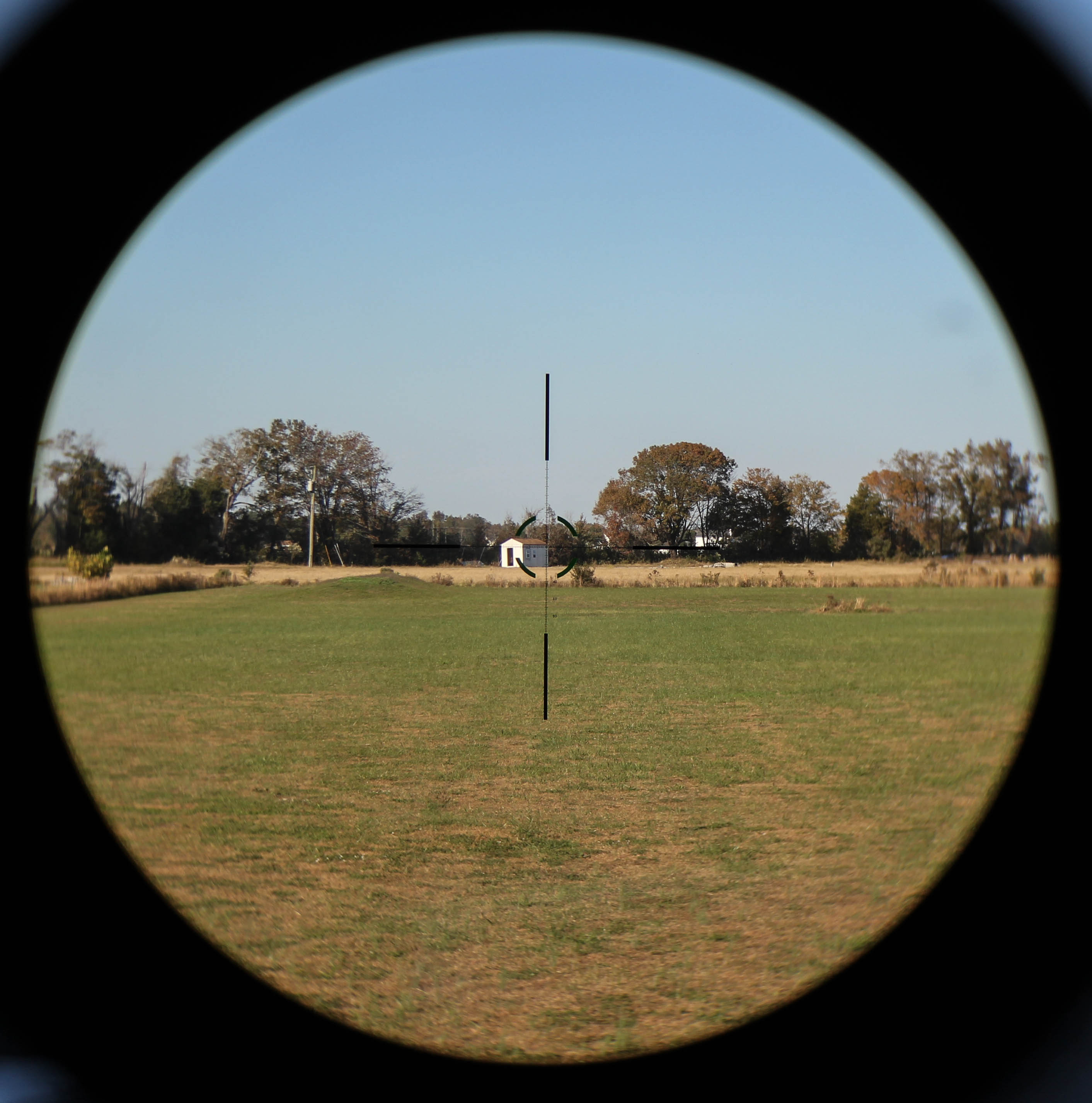 The Accupower reticle at 1x. Building is at 300 yards.[/caption] On 1x power, the illuminated reticle appears almost like a segmented EOTech reticle (with a crosshair in the background). The large circle with center "dot" makes up-close target acquisition easy. On higher magnification, the center cross comes into sharper focus for more precision. Now, one of my critiques about the scope is the size of the center cross. According to Trijicon's literature, the center cross is 4 MOA. To be honest, I really wish they could get it down to something much smaller. With that said, the center cross is a compromise. Make it too small and you lose functionality at lower power. Make it too big, and you get me complaining about it at higher power. I wish they could get it down, but it works, and while I don't consider it a major strike against the scope, it's something to keep in mind for more precise work. [caption id="attachment_1238" align="alignnone" width="2773"]
The Accupower reticle at 1x. Building is at 300 yards.[/caption] On 1x power, the illuminated reticle appears almost like a segmented EOTech reticle (with a crosshair in the background). The large circle with center "dot" makes up-close target acquisition easy. On higher magnification, the center cross comes into sharper focus for more precision. Now, one of my critiques about the scope is the size of the center cross. According to Trijicon's literature, the center cross is 4 MOA. To be honest, I really wish they could get it down to something much smaller. With that said, the center cross is a compromise. Make it too small and you lose functionality at lower power. Make it too big, and you get me complaining about it at higher power. I wish they could get it down, but it works, and while I don't consider it a major strike against the scope, it's something to keep in mind for more precise work. [caption id="attachment_1238" align="alignnone" width="2773"]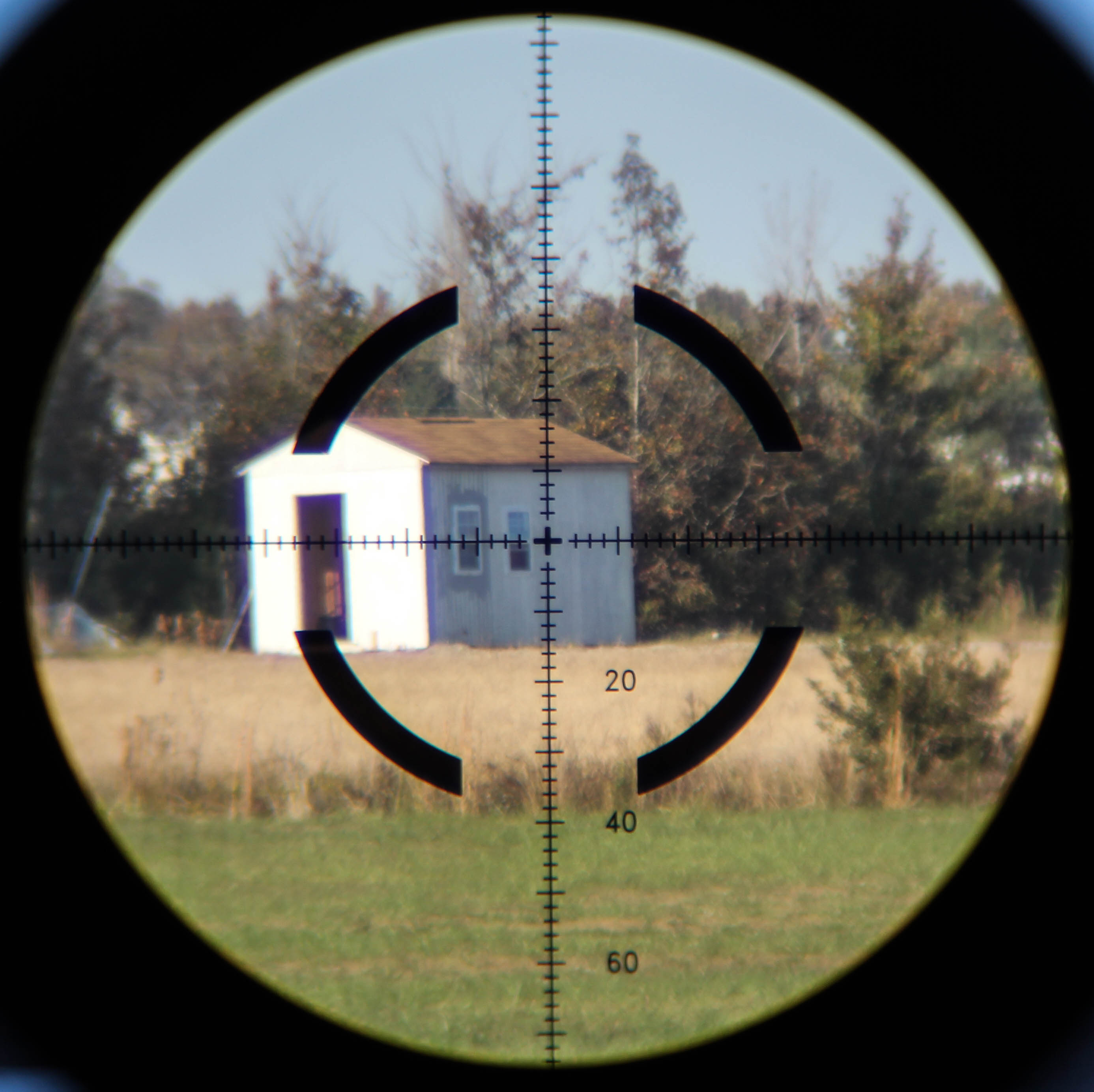 The Accupower reticle at 8x. Building is at 300 yards.[/caption] After using scopes with both red and green illuminated reticles, my personal preference is definitely red. I don't feel like I get enough contrast in brighter light with the green reticle. Fortunately, the Accupower comes in both, so you can get the one that best suits your needs.
The Accupower reticle at 8x. Building is at 300 yards.[/caption] After using scopes with both red and green illuminated reticles, my personal preference is definitely red. I don't feel like I get enough contrast in brighter light with the green reticle. Fortunately, the Accupower comes in both, so you can get the one that best suits your needs.
Weight
The Accupower is definitely going to add some heft to your rifle. At an advertised weight of 25 ounces, it's adding a pound and a half before you even put it in its mount. When combined with my Geissele mount, it adds just over two pounds to the rifle. Probably not a huge deal if you're running the rifle out of a patrol vehicle or otherwise, but if you're humping it over a long distance, you'll want to keep that in mind. I think the weight is acceptable for my needs, especially given the sturdiness of the optic and the ease of use of the controls. [caption id="attachment_1234" align="alignnone" width="5184"]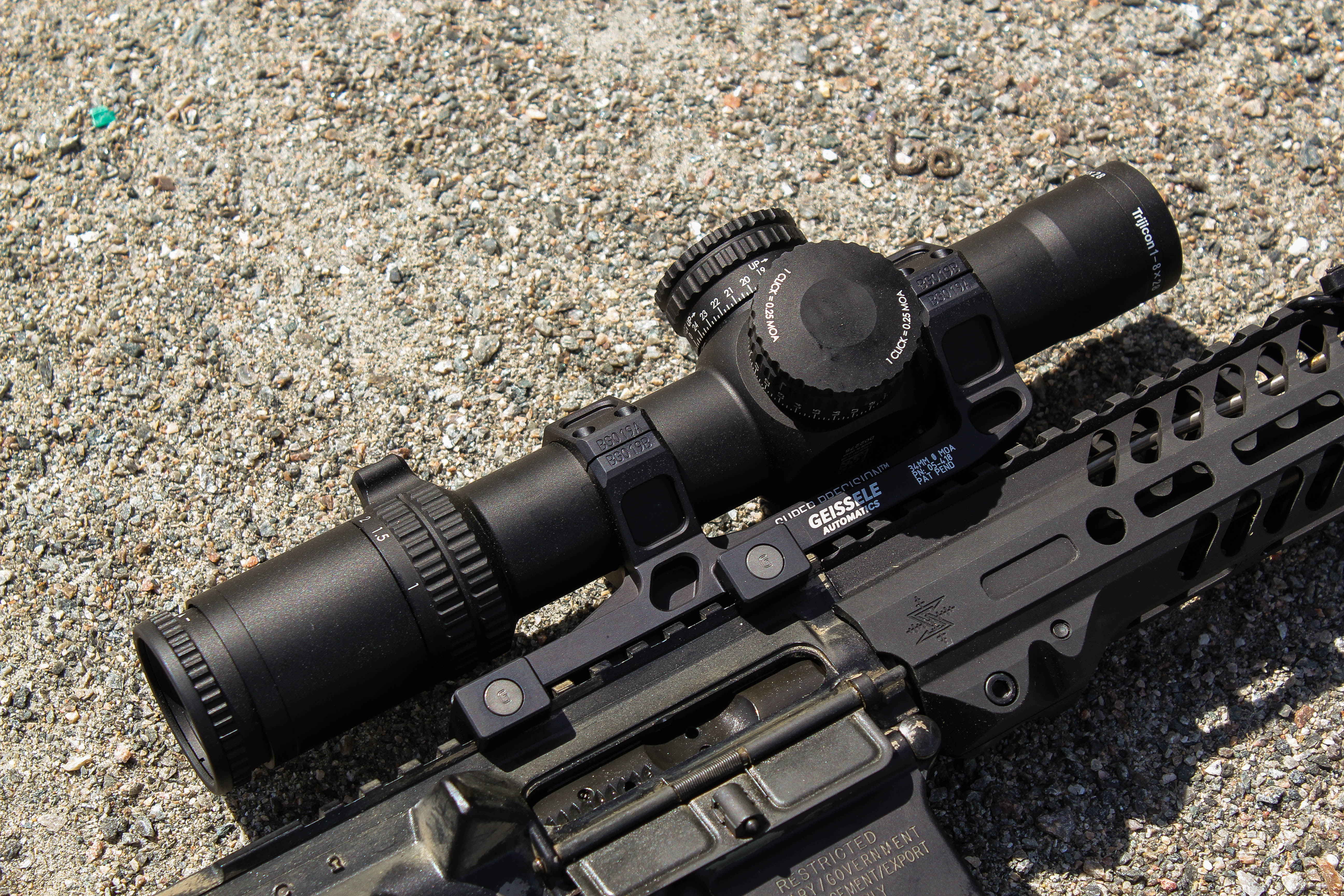 The Accupower 1-8x28 is a solid, all-around optic for those needing a duty-grade LPVO[/caption]
The Accupower 1-8x28 is a solid, all-around optic for those needing a duty-grade LPVO[/caption]
Conclusion
I found the Accupower to be an excellent candidate for a duty rifle scope. It's perfectly suited for a patrol officer, especially in a suburban or rural environment combining distance and buildings. It's built for professional use, and it comes with a professional price tag of $1,699 (MSRP), but the quality of the optic is undeniable, and the street price is closer to similar optics from their competitors. The clarity, controls, and reticle all combine into a scope with serious capability for the asking price. This will be on my short list of optics for future purchase. I hope this has been helpful. If so, feel free to share. As always, Rainier Arms stands ready to help you Pursue Your Passion.







